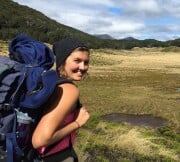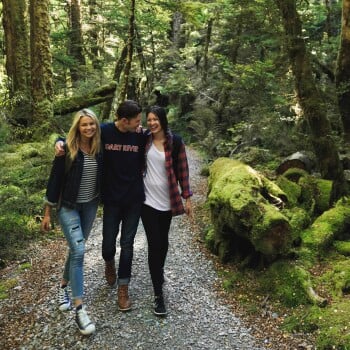- About Us
-
Trips
-
 Kiwi-Style Hiking
Kiwi-Style Hiking
-
 Great Walks
Great Walks
-
 Hiking Tours
Hiking Tours
-
Alpine Hikes
-
Custom Groups
- Huayhuash Trek
- Family Northern Explorer
- Family Southern Explorer
- Lake Waikaremoana Hike
- Women's Custom Tours
- Women's Southern Wilderness
- Coast, Canyons and Mountains
- Coastal Wanderer Custom Tour
- Don't Cross the Ladies
- Secret South Custom Tour
- Tekapo Hike
- West Coast Custom Tour
- World Heritage Custom Tour
-
- Blog
- Shortlist
- About Us
- Trips
- Blog
- Shortlist

Sep 6, 2021
Urgh!!! Maggots everywhere!! I look inside the trap and see a humungous, partly disintegrated rat dripping with maggots. The smell is unbearable. My insides heave. How am I going to remove this festering beast? It is beyond me...
This was in my early days as a trapper and it’s still the worst catch ever. Although a vivid memory, I have grown immensely from this experience. Now I don’t think twice about removing rats or mustelids (stoats, ferrets, weasels. in fact, I actually get excited catching the little menaces, knowing that I’m helping in the big scheme of things.
A murderous workday
One of my students (I sometimes work as a teacher) wondered what a murderous workday looks like in the bush.
There is no typical trapping day - they all feel so different, the weather, the trails the things you see and experience. A day in the life of a trapper - Adrienne.
I open my eyes as the daylight filters in, excited as to what the day will bring. I’m grateful to be in our cosy wilderness hut up the Poulter Valley with our neighbours the birds chattering away outside. After fuelling up with poached eggs on toast, we gather around the table listening to the team leader’s briefing. Included in this briefing is a battle with my colleague to see who will take the best trapline - ‘paper, scissors, rock’ decides it. Bummer, I lost. I take the flatter trap line and not the sort after high line with views and the nicest forests. My pack brims with warm clothes and rain gear, first aid, a survival kit, head torch, radio, personal locator beacon (PLB), a hefty lunch and snacks, snacks and more snacks. Although you soon learn to love the remoteness and challenge you need to be prepared when working by yourself in the bush. My high-vis vest, bum bag full of trapping tools and slightly damp boots are the last items strapped on.

Golden tussocks and icy water
It’s a clear crisp Autumn day, not a breath of wind, and I smile to myself at the beauty surrounding me, golden tussocks, gigantic gentle maunga (mountains) rising up to meet the piercing blue sky. Ah, what a way to start the day!
I have a whopping 80 traps to check today, spread over 5km. This trapline follows the forest edge beside the Poulter River. Two different traps are placed beside each other 50m apart. The older style Fenn traps need to be removed from the box, set and carefully placed down. They are being phased out to make way for the more modern DOC 200 traps which are sturdy ‘lethal, fast, finger breaking bad boys’.
After an easy 5kms I get to the Casey Stream, a side river that today has a low flow and is easily crossable. After rainfall, this river rises rapidly and can cut us off to the whole upper valley network of traps. Backcountry skills are essential when assessing rivers. I make my way across the stony river bed and as the icy water seeps through my gaiters my levels of alertness rise. I have become so accustomed to having wet feet, every day we cross a river or two. Dry feet are a forgotten luxury!
Rotten eggs and flying rats
The track weaves up through the ngahere (forest) and with the noise of the rivers behind me the quietness is rejuvenating. I notice new forms of life all around - mushrooms poking their heads out of the most peculiar places and tiny fern fronds unfurling. I feel calm and my thoughts are clear and present. At my first trap, I get a slight whiff of something stenchy - there must be a predator inside. My body goes into auto-pilot, I grab my spanner, unscrew the screw and apprehensively lift the lid. Although I have checked hundreds of traps, my imagination still runs wild. YES!! I’ve got a little sucker, it’s a satisfying feeling catching a rat or stoat. Funnily enough, having no pests in the traps also feels like a reward, a positive sign as well, indicating that there are fewer pests around.
‘POP’ the rotten egg smashes against a faraway tree. I’ve fine-tuned my egg-throwing skills, it is now quite an enjoyable activity biffing the old eggs away. In each trap, we alternate placing either PCR (groundfish) or Erayz (ground rabbit) bait to attract the pests alongside an egg which is the visual lure. Finally, I clear the rat, watching it fly through the air, legs spread wide apart on its final journey to provide nutrients back to the forest. Take that.

Afternoon tea with a robin
I get into a rhythm and work hard servicing multiple traps. I feel a bit peckish, so I find a sunny spot to perch. I cherish these breaks as it gives me time to look around and take in my surroundings. The fresh damp beech tree leaves fill my nostrils as I relax and seem to disappear into the earth. A curious wee robin scutters along to keep me company, tiptoeing up and sussing me out, becoming more confident to hop closer as I sit quietly and pose no threat. I can see how easily ground-dwelling birds get targeted by predators.
The track eventually bursts out into a mini alpine plant oasis, dotted with spear grass, coprosmas, and hebes. The path edges are boarded by a delicate white coral moss, which I carefully avoid stepping on. The sparse views in front of me keep me entertained as I walk up the valley – the beauty of the mountains never gets old. My mobile phone lets off a tinkle as I’m approaching a trap, as get closer I see the markers, the GPS only gets us to 10-20m. This clever trapping app works without mobile coverage is GPS enabled and is a vital tool for managing such a vast network of traps. Occasionally I have to scamper across a boggy tussocky section to reach a trap. Today there are plenty of rats in the traps to keep me busy – perhaps 1 rat in every 3 traps. These critters are commonly found at lower altitudes near rivers or streams.
Effortless walking
The rest of the day is reasonably uneventful, at my last trap I turn and start waltzing back down the valley, striding out, feeling the warmth of the sun on my back. I chuck on some tunes on my phone and blissfully wonder if life can get any better. Walking feels effortless, almost floating like I’m part of the current of the river beside me. As I approach our cosy whare (hut) I see one of my workmates is back already and has lit the fire. I settle in and share the day's accomplishments.






